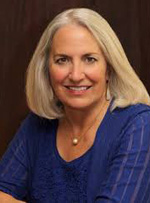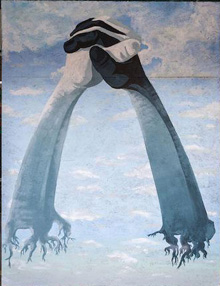 Carol Swartout Klein, a native of Ferguson, MO, always dreamed of writing a children’s book. When she saw her community come together to heal after unrest in the city, she was inspired. Her debut book, Painting for Peace in Ferguson, was named one of ILA Teachers’ Choices for 2016.
Carol Swartout Klein, a native of Ferguson, MO, always dreamed of writing a children’s book. When she saw her community come together to heal after unrest in the city, she was inspired. Her debut book, Painting for Peace in Ferguson, was named one of ILA Teachers’ Choices for 2016.
Your bio says you always wanted to write a children’s book. Why haven’t you before now?
While I have had several ideas in mind for a children’s book in the past I think sometimes a story finds you. And that was the case for Painting for Peace in Ferguson. I grew up in Ferguson, and like many in the community, I was in shock and was so saddened and disheartened by the unrest and by the understandable anger that caused it. It became a story that was personal for me—of witnessing an incredibly hopeful moment that moved me to tears…when after months of tension, I saw people coming together, caring…in this case through painting. When I witnessed the community coming together to create these amazing larger-than-life murals just days after fires had left Ferguson devastated I knew that this was an inspirational story that I wanted to somehow share.
When the painting was happening, did you know then you would write this book?
I don’t consider myself very artistic, but I have always written and worked with artists…so I thought if I wrote a book and donated all the profits to Ferguson that could be my way of giving back. What really gave me the idea of just how to tell this story was remembering the Mr. Rogers quote, “When you see scary things on the news, look for the helpers…you will always find helpers.” With that I said to my husband, “What I’d really like for Christmas this year is to focus on nothing but writing and producing a children’s book about what just happened.” In addition to all the profits going back to the community, I also wanted to work with only local suppliers, from the publisher to the printer, so that the money stayed within the community. Within 60 days after hiring professional photographers, finding a publisher, appealing through social media for snapshots, getting photo releases, and many late nights, Painting for Peace in Ferguson was born.
What role do you think art has in the healing process?
Art has played a key role throughout history from being cathartic to challenging, allowing people to work through emotions and grapple with changes in creative ways. It was interesting to me that many of the organizers of this event were actually art therapists. The painting gave people the ability to express emotions and make new connections with others they had never before met while painting side by side. It truly became an exercise in art therapy on a community-wide level. As the Ferguson community and St. Louis region continue to change and work toward a better future for all of its residents, artists will continue to reflect on where we’ve been and cast a light on where we might be headed.
Are the paintings still up, or are they in storage or collected somewhere?
Actually we have some really exciting news. All but a couple of the paintings have been taken down at this point. For the past six months, we have been preparing for an exhibition sponsored by COCA—the Center of Creative Arts—a diverse arts education center and the largest multidisciplinary arts institution in St. Louis. They are the backbone arts organization sponsoring an exhibit of several dozen of the original murals, some of which are massive in scale, in six locations in the St. Louis area. To my knowledge, this is the first-ever multi-location collaborative exhibit in the city. Art will be exhibited at the Missouri History Museum, the Sheldon Performing Arts Center, the University of Missouri-St. Louis, the Vaughn Cultural Center, the Ferguson Youth Initiative and, of course, COCA. The exhibit opens August 27 with the final location finishing its exhibit November 19.
Do you have a favorite piece and, if so, which one?
 Perhaps the most iconic image of this whole movement was the black and white Unity Hands, which shows black and white hands coming together in the shape of the St. Louis Gateway Arch shown on page 13 of the children’s book, painted by Ana Bonfilla. As she says, “We are split apart as a community. But, my hope is that eventually we can come together.” According to Ana, the roots at the bottom signify “We are going to have to uproot ourselves in order to come together and make a better future. We can’t just stay where we are.”
Perhaps the most iconic image of this whole movement was the black and white Unity Hands, which shows black and white hands coming together in the shape of the St. Louis Gateway Arch shown on page 13 of the children’s book, painted by Ana Bonfilla. As she says, “We are split apart as a community. But, my hope is that eventually we can come together.” According to Ana, the roots at the bottom signify “We are going to have to uproot ourselves in order to come together and make a better future. We can’t just stay where we are.”
But the story that really touches me the most was the huge painting that covered almost two dozen pieces of plywood on Ferguson City Hall. Painted by a half dozen artists, the art evolved as it was being painted. In the center is a large tree designed by Sheri Goldsmith showing leaves painted with words that are important for a healthy community—respect, hope, opportunity, and education. Stylistically the leaves are then spread by the wind in swirls on two huge side panels reminiscent of a Van Gogh painting to bring these positive wishes out into the community. As Sheri describes it, “The Missouri National Guard, who still had members stationed protecting City Hall at the times, asked if one of their emblems could be included in the painting, signifying their inclusion in the wishes for healing.” If you look closely you can see that a shoulder patch from one of the guardsmen is attached on one of the letters of City Hall. This one image captures the desires of so many for unity. Just one of many remarkable stories that happened during “Paint for Peace” and a story that I felt privileged to tell.
 April Hall is editor of Literacy Daily. A journalist for 20 years, she has specialized in education, writing and editing for newspapers, websites, and magazines.
April Hall is editor of Literacy Daily. A journalist for 20 years, she has specialized in education, writing and editing for newspapers, websites, and magazines.